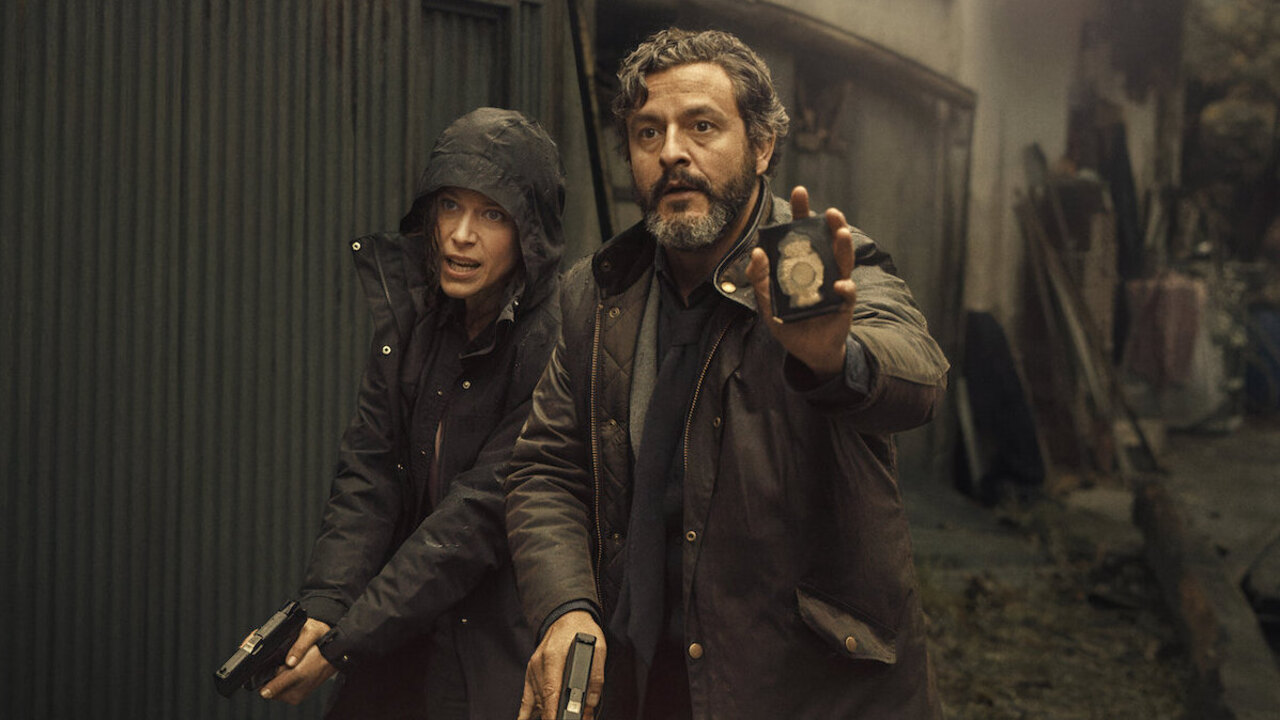With our world slowly stepping into pandemic fatigue, it is only a matter of time before every film genre begins to reflect on the COVID-19 pandemic. Only last month, we had Sick (2023), a slasher film by Kevin Williamson, set amidst the early days of the catastrophe. February brings us Infiesto (2023), a new detective mystery from Netflix, where the pandemic plays a much more significant part than Williamson’s flick. Infiesto, which has a tight 90-minute runtime, is a somewhat familiar yet incredibly well-paced thriller whose temporal groundings help distinguish it from other genre flicks.
Infiesto begins with an announcement by the Spanish government of a fifteen-day lockdown in the country due to the coronavirus. Just as the authorities and state bodies are preoccupied with the looming threat of the virus, a scarred teenage girl shows up on the streets. The teenager is Saioa (Andrea Barrado)—a girl abducted months ago and presumed dead since. While a brutally traumatized Saioa is being treated at the hospital, Lieutenant Samuel Garcia (Isak Férriz) and his female sub-inspector Castro (Iria del Río) are assigned to the case. Their only clue is a sinister symbol branded on Saioa’s back. The duo’s investigation leads them to the small town of Infiesto, where everybody knows one another and people are not who they appear to be.
Initially appearing to be just a child abduction case, Garcia and Castro soon realize that a much more disturbing network is at play. They must race against time before another young life is jeopardized. As they navigate a labyrinth of suspects, the officers are led to a mysterious man, only known as ‘The Prophet,’ who harbors a sinister plot. Can the tenacious duo uncover the identity of The Prophet and his nefarious plot before it’s too late?
Infiesto bears a resemblance to other small-town detective mysteries with the likes of Nolan’s Insomnia (2002), Wind River (2017), Twin Peaks (although without the show’s signature quirk), and a bit of Fincher’s Se7en. Cinematographer Josu Inchaustegui uses a dusky color palette to portray a world that seems supposedly drained of color—a choice that aligns well with the film’s grimly apocalyptic world.
Narratively, director-writer Patxi Amezcua takes cues from several of the aforementioned films, whether in plot or character. In Garcia’s character, we have the stock character of the lead detective, who is always grim. He has a tortured past and lives somewhat separated from his family and kids. There is also the unhinged lunatic (acted unnervingly by José Manuel Poga) whose dissimulation tests the patience of the detectives.
Despite these familiarities, Infiesto works because Amezcua invests care and time into his characters and situations, ensuring that each sequence isn’t executed sloppily. Alongside the brooding mystery at its center, we are given substantial info about the two sleuths who are heading the investigation. Garcia cannot visit his mother at the nursing home center due to COVID restrictions. Moreover, he can only communicate with his kids via a rushed Zoom call. On the other hand, Castro is self-isolating with her sick boyfriend, whose condition continues to deteriorate. Coupled with their tumultuous personal lives is the incessant pressure to solve the case before the media gets hold of any information. Amezcua deftly incorporates the pandemic setting into his narrative and character development which helps in not reducing the virus to just a gimmick.
Isak Férriz and Ira del Río are at the center of the film and dexterously embody the portrayal of the stern detective and his diligent protegee, respectively. Even without explicit communication, Férriz and del Rio create a convincing tacit camaraderie between their characters, which helps to hammer home the film’s dramatic weight when things get murky. Río’s character is especially memorable, given the trajectory of her character in the film’s third act. But while the film sets up her potential as other genre legends like Clarice Starling, the rushed finale sequence fails to deliver on that promise.
But apart from this substandard finale and other familiar leanings, the film’s most fatal flaw is in the exploration of its themes. The famed detective novelist P.D. James once mentioned how the detective story is “not about murder but the restoration of order.” By scapegoating the culprit, the detective brings peace and order into society. Even though Infiesto employs a similar framework, it takes the easy conservative way out to ensure this scapegoating.
To say too much would spoil the film, but the film’s scapegoats are the outlaws of its society—the outsiders who have found a morbid interest in paganism. Unlike the much more nuanced Mare of Easttown and the Australian thriller The Dry, which rooted their culprits amidst everyday suburbia, Infiesto settles for the conventional tactics of blaming the outsider. A last-minute twist comes to upend this trope. However, by that time, the film’s procedural politics have already cemented the culprit.
An unsaid rule in genre writing is to follow the rules and conventions set by the previous films, and you will end up with a serviceable product. Infiesto does just that, resulting in a taut little thriller that makes the most of its setting and runtime. It could have done more to subvert its traditional ideological leanings. Still, for a ninety-minute feature film that dexterously replicates the relentlessly murky and apocalyptic feel of the pandemic, Infiesto is definitely worth seeing.


![Hawk’s Muffin [2022]: ‘IFFR’ Review – A Metaphor for Perpetual Human Conflict Enveloped in Dystopian Science-Fiction](https://79468c92.delivery.rocketcdn.me/wp-content/uploads/2022/01/Hawks-Muffin-Still-9-768x432.jpg)
![The Day After I’m Gone [2019] MUBI Review – A Father-Daughter Relationship Drama that Investigates Grief and Mental Illness](https://79468c92.delivery.rocketcdn.me/wp-content/uploads/2019/02/The_Day_After_Im_Gone_HOF1-768x322.jpg)



